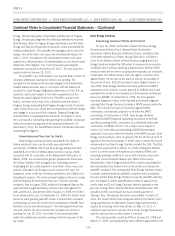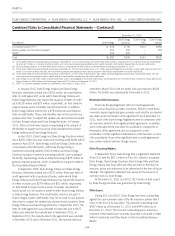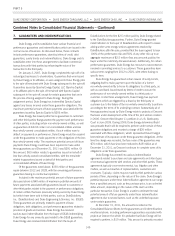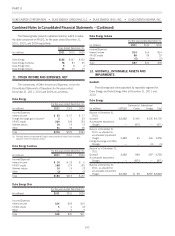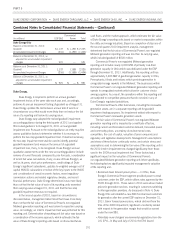Duke Energy 2011 Annual Report Download - page 163
Download and view the complete annual report
Please find page 163 of the 2011 Duke Energy annual report below. You can navigate through the pages in the report by either clicking on the pages listed below, or by using the keyword search tool below to find specific information within the annual report.
PART II
DUKE ENERGY CORPORATION •DUKE ENERGY CAROLINAS, LLC •DUKE ENERGY OHIO, INC. •DUKE ENERGY INDIANA, INC.
Combined Notes to Consolidated Financial Statements – (Continued)
facility up to specified sublimits for each borrower. However, Duke
Energy has the unilateral ability at any time to increase or decrease
the borrowing sublimits of each borrower, subject to a maximum
sublimit for each borrower. See the table below for the borrowing
sublimits for each of the borrowers as of December 31, 2011. The
amount available under the master credit facility has been reduced,
as indicated in the table below, by the use of the master credit facility
to backstop the issuances of commercial paper, letters of credit and
certain tax-exempt bonds. As indicated, borrowing sub limits for the
Subsidiary Registrants are also reduced for amounts outstanding
under the money pool arrangement.
Master Credit Facility Summary as of December 31, 2011 (in millions)(a)(b)
Duke Energy
(Parent)
Duke Energy
Carolinas
Duke Energy
Ohio
Duke Energy
Indiana
Total
Duke Energy
Facility Size(c) $1,250 $1,250 $800 $ 700 $4,000
Less:
Notes Payable and Commercial Paper(d) (75) (300) — (150) (525)
Outstanding Letters of Credit (51) (7) (27) — (85)
Tax-Exempt Bonds — (95) (84) (81) (260)
Available Capacity $1,124 $ 848 $689 $ 469 $3,130
(a) This summary only includes Duke Energy’s master credit facility and, accordingly, excludes certain demand facilities and committed facilities that are insignificant in size or which
generally support very specific requirements, which primarily include facilities that backstop various outstanding tax-exempt bonds. These facilities that backstop various outstanding
tax-exempt bonds generally have non-cancelable terms in excess of one year from the balance sheet date, such that the Duke Energy Registrants have the ability to refinance such
borrowings on a long-term basis. Accordingly, such borrowings are reflected as Long-term Debt on the Consolidated Balance Sheets of the respective Duke Energy Registrant.
(b) Credit facility contains a covenant requiring the debt-to-total capitalization ratio to not exceed 65% for each borrower.
(c) Represents the sublimit of each borrower at December 31, 2011. The Duke Energy Ohio sublimit includes $100 million for Duke Energy Kentucky.
(d) Duke Energy issued $450 million of Commercial Paper and loaned the proceeds through the money pool to Duke Energy Carolinas and Duke Energy Indiana (see money pool table
above). The balances are classified as long-term borrowings within Long-term Debt in Duke Energy Carolinas’ and Duke Energy Indiana’s Consolidated Balance Sheets. Duke Energy
issued an additional $75 million of Commercial Paper in 2011. The balance is classified as Notes payable and commercial paper on Duke Energy’s Consolidated Balance Sheets.
At December 31, 2011 and 2010, various tax-exempt bonds,
commercial paper issuances and money pool borrowings were
classified as Long-term Debt on the Consolidated Balance Sheets.
These variable rate tax-exempt bonds, commercial paper issuances
and money pool borrowings, which are short-term obligations by
nature, are classified as long term due to Duke Energy’s intent and
ability to utilize such borrowings as long-term financing. As Duke
Energy’s master credit facility and other specific purpose credit
facilities have non-cancelable terms in excess of one year as of the
balance sheet date, Duke Energy has the ability to refinance these
short-term obligations on a long-term basis. The following tables
show short-term obligations classified as long-term debt as of
December 31, 2011 and 2010:
Short-term obligations classified as long term
December 31, 2011
(in millions) Duke Energy
Duke Energy
Carolinas
Duke Energy
Ohio
Duke Energy
Indiana
Tax exempt bonds(a)(b)(c)(d) $ 491 $ 95 $111 $285
Notes payable and Commercial paper(e) 450 300 — 150
DERF(f) 300 300 — —
Total $1,241 $695 $111 $435
(a) Of the $491 million of tax-exempt bonds outstanding at December 31, 2011 at Duke Energy, the master credit facility served as a backstop for $287 million of these tax-exempt bonds
(of which $27 million is in the form of letters of credit), with the remaining balance backstopped by other specific long-term credit facilities separate from the master credit facility.
(b) For Duke Energy Carolinas, the master credit facility served as a backstop for the $95 million of tax-exempt bonds outstanding at December 31, 2011.
(c) All of the $111 million of tax-exempt bonds outstanding at December 31, 2011 at Duke Energy Ohio were backstopped by Duke Energy’s master credit facility (of which $27 million is
in the form of letters of credit).
(d) Of the $285 million of tax-exempt bonds outstanding at December 31, 2011 at Duke Energy Indiana, $81 million were backstopped by Duke Energy’s master credit facility, with the
remaining balance backstopped by other specific long-term credit facilities separate from the master credit facility.
(e) Duke Energy has issued $450 million in Commercial Paper, which is backstopped by the master credit facility, and the proceeds are in the form of loans through the money pool to Duke
Energy Carolinas of $300 million and Duke Energy Indiana of $150 million as of December 31, 2011.
(f) DERF is a short-term obligation backed by a credit facility which expires in August 2013.
143




